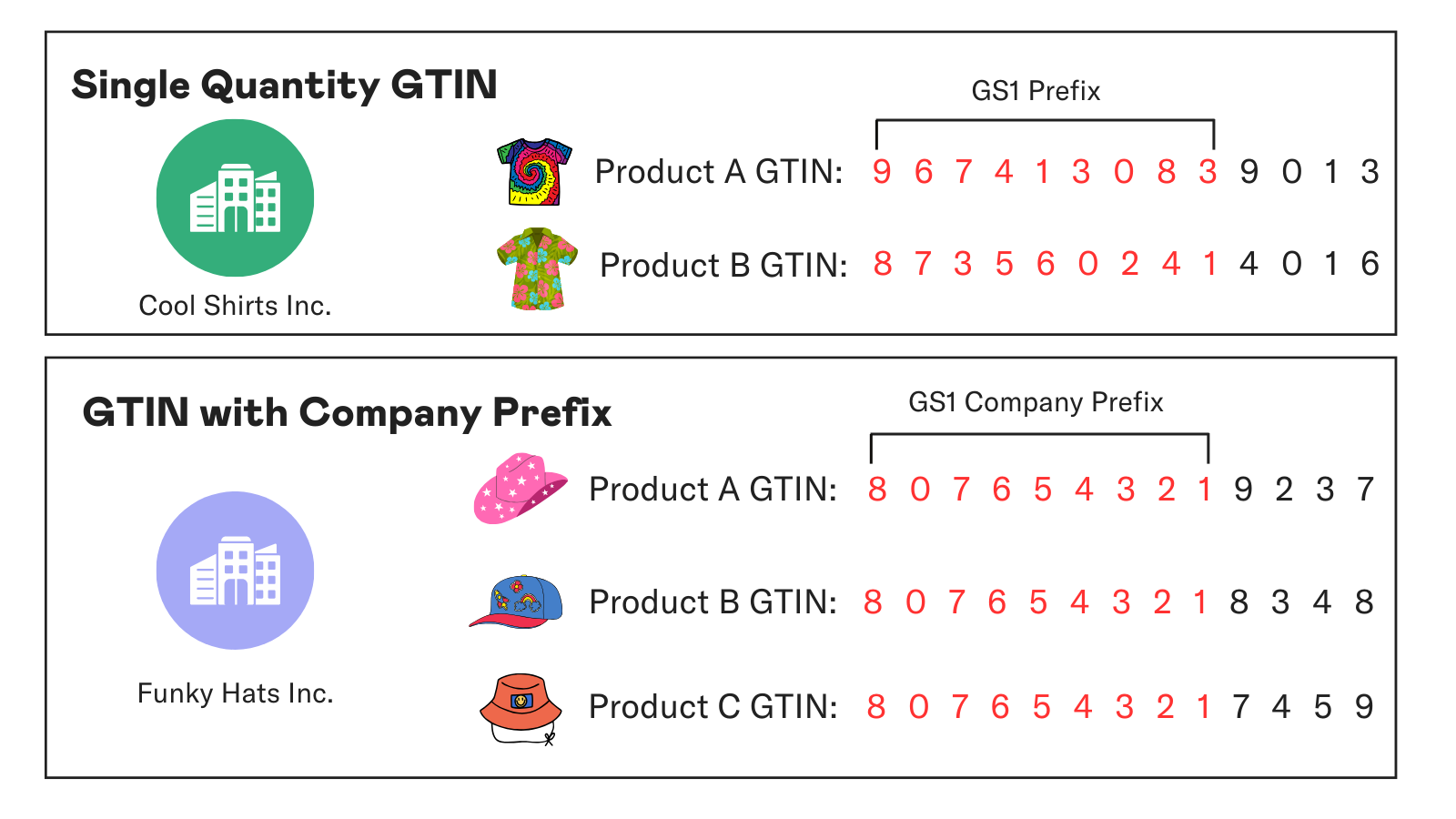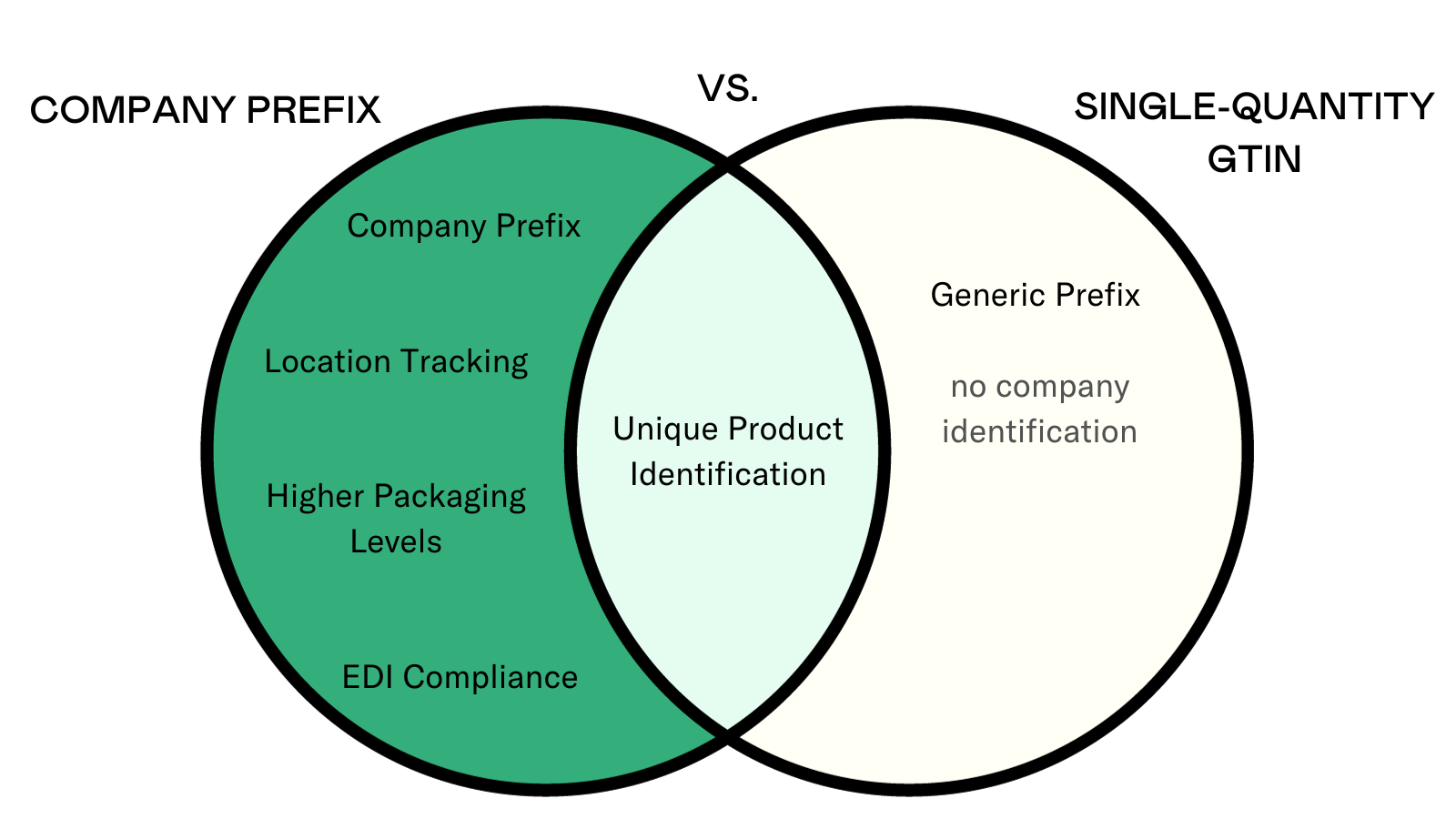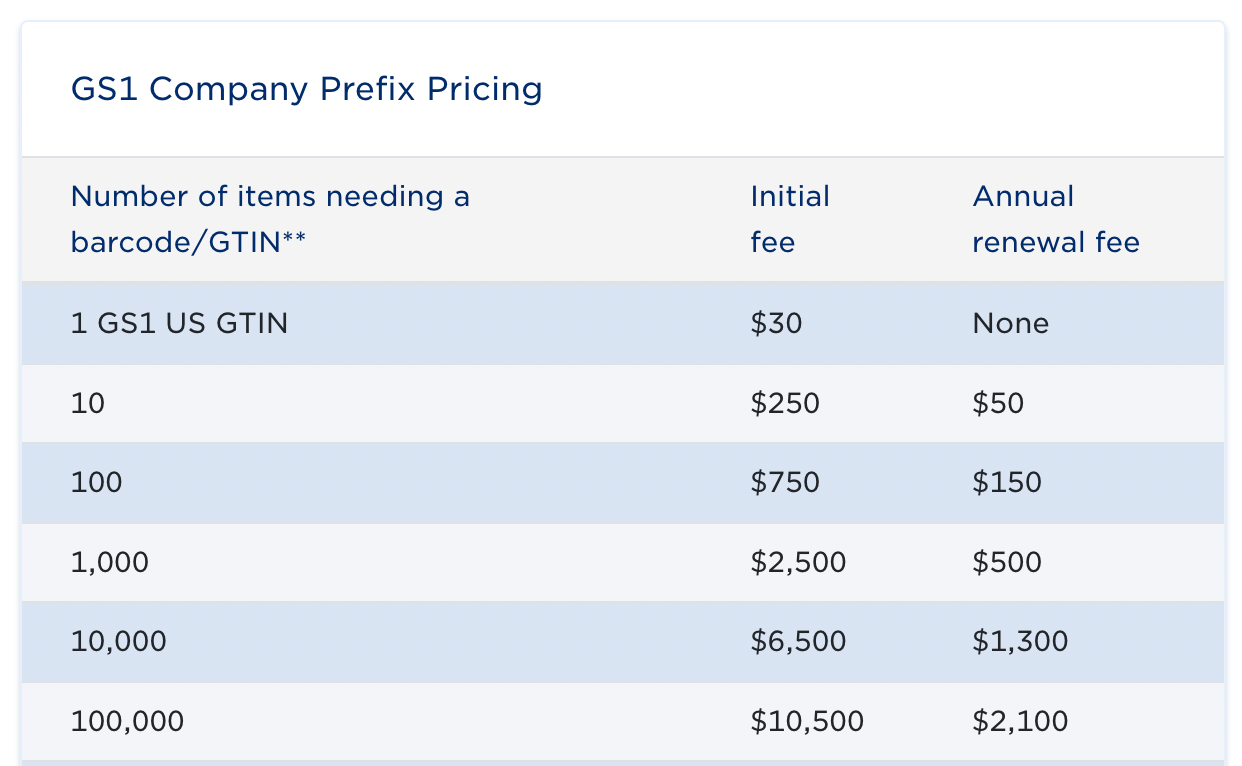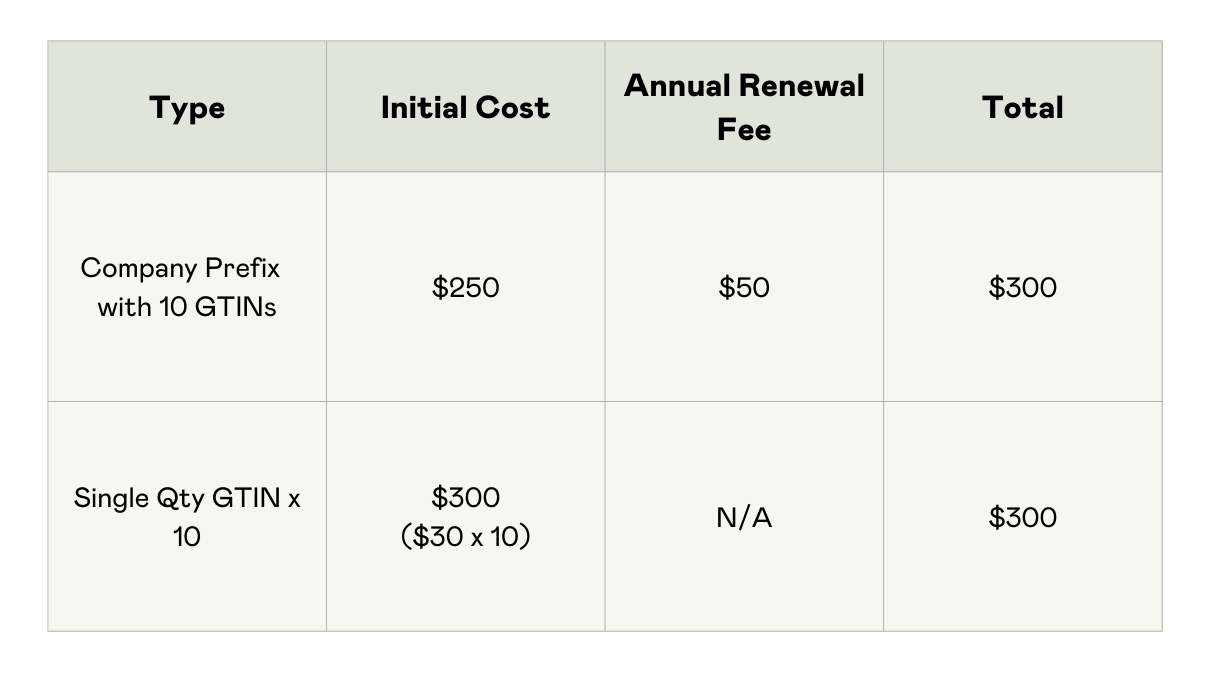 All blog posts
All blog posts
Should I buy Single GTINs or use Company Prefixes?
If you’re looking to expand into retail, list your products on platforms like Google Shopping, or even syndicate reviews to your Shopping Ads, you’ve probably been told that your products need GTINs.
These unique identifiers come in two options: single-quantity GTINs and Company Prefixes. While single-quantity GTINs are cheaper, especially for smaller product lines, the decision to opt for a Company Prefix should not be purely based on immediate cost savings. It's crucial to recognize the limitations of single-quantity GTINs.
Options for purchasing GTINs
GS1 is the governing body that sets the standards for GTINs and is responsible for managing, indexing, and distributing them. In order for a company to get GTINs, they must be purchased from a GS1 member organization.
Historically, the only option was to purchase GTINs in batches of 10, 100, 1,000, 10,000 or 100,000. This is called “licensing GTINs”, where companies pay an initial fee to obtain their batch of GTINs and then pay an annual fee so they can continue using them.
In 2020, GS1 introduced a single-quantity GTIN option catered towards small businesses. This allowed companies to purchase GTINs one at a time and not pay an annual renewal fee.
The reason why GS1 introduced single-quantity GTINs
One of the concerns from sellers about going to GS1 to purchase GTINs was how expensive they were. In a lot of cases, these were brands that launched with a single product and were looking to sell on Amazon right away (since Amazon requires all products to have a GTIN). These brands only needed 1 or 2 GTINs and purchasing a batch of 10 GTINs was too expensive. GS1 saw the need to offer different access points to these smaller sellers and decided to introduce the single-quantity GTIN as a more affordable option.
The single-quantity GTIN was a game changer for small businesses. They made it possible for smaller sellers to list their products on Amazon and even syndicate reviews to Shopping Ads to boost performance. Despite their advantages, single-quantity GTINs have their limitations and shouldn't be used by every brand out there.
The difference between single-quantity GTINs and Company Prefixes
The core difference between a single-quantity GTIN and GTINs with Company Prefixes is in how they're structured.
When GTINs are licensed they have what’s called a Company Prefix, which is a unique set of numbers at the beginning of each GTIN that identifies your company as the owner of a product. Only your company can use your Company Prefix, which makes it easier for trade partners and retailers to identify your products.
Single quantity GTINs will use GS1 Prefixes. These are issued by the Global GS1 office to GS1 Member Organizations (i.e. GS1 US, GS1 UK,) and are used when issuing individual GTINs.

Since the structure of a Company Prefix makes it possible to tie a product to a company, this creates extra functionality that single-quantity GITNs don't possess.
What can Company Prefixes do that single-quantity GTINs can’t?
Single-quantity GTINs were created in an effort to make GTINs more affordable for new small businesses that only have 1 or 2 products. They’re basically a tool to help businesses start selling on Amazon when they don’t have a large budget.
Because of their narrow use case and the way they’re structured, single-quantity GTINs don’t have as much functionality as GTINs with Company Prefixes.
Below is a list of the extra functionality Company Prefixes have that single-quantity GTINs don't.
Location tracking - when you purchase a Company Prefix, you also get a Global Location Number (GLN). This is a unique number issued by GS1 that identifies legal entities (ex. Corporations, Subsidiaries) and locations (ex. warehouses, shipping vessels). The GLN is made up of your Company Prefix number, which is why it can’t be issued with a single quantity GTIN. A GLN is used when there’s a need to identify specific locations along the supply chain.
Higher packaging levels - when you have a Company Prefix, you can now use GTINs to identify cases and pallets of your products instead of just single units. Higher packaging levels become relevant when brands start to scale and expand into retail. When a retailer receives thousands of pallets of different products, there needs to be a way to quickly identify which pallet of products belongs to whom so it can get to the correct location. Additional GTINs that have a company’s Prefix are needed to differentiate single units of a product from cases that contain the same product.
EDI compliance - electronic data interchange (EDI) is the exchange of electronic information between two parties. It’s used throughout supply chains to exchange information about products and the operations involved in moving them from point A to B. Many retailers such as Walmart and Target, make Company Prefixes a part of their EDI requirements. For example, in order to list your products with Walmart, your shipping containers need a Serial Shipping Container Code (SSCC) to identify logistic units (i.e. cases, pallets, air cargo containers) in the supply chain. GS1 Company Prefixes are encoded into SSCCs to ensure that no SSCC labels are repeated as this causes backups at the point of receipt and will lead to chargebacks from the retailer to the vendor.
Retailers also prefer Company Prefixes because they make it easier to identify products. Instead of having to look up each individual GTIN, they can simply look at the first few digits of the GTIN and know which company the product belongs to.

How to decide between a company prefix and a single quantity GTIN
When deciding to purchase single-quantity GTINs versus licensing a Company Prefix the first thing to consider is how many you need. Let’s remind ourselves of the different costs associated with each purchasing option for GTINs:

If you have 9 or 10 products, it’s obvious that you should purchase a Prefix with 10 licenses because it costs the same as buying 10 separate GTINs.

The decision becomes unclear when brands have somewhere between 10 and 100 products. Let’s say you have 15 products, the decision is to either buy 15 individual GTINs for $450 or buy a Prefix with 100 GTIN licenses for $750 (plus an annual renewal fee of $150). Is it worth it to save the initial $300 and just buy 15 separate GTINs? No. Let us explain.
Factors to consider
Purchasing GTINs for your products is a business decision and it should be thought of as an investment towards the growth of your business. Cheaping out and buying single GTINs will only make your life harder if you have any ambitions to expand your product line or venture into retail.
Yes, you will save $300 dollars upfront and avoid the $150 renewal fee if you buy 15 separate GTINs. However, if you have any plans to expand your product offering or introduce new variants, you’ll have to buy a new GTIN every time. In the end, this can become more costly and complicates the task of managing and assigning GTINs in your product catalog.
The number of products in your catalog is only one factor, the other equally important factor to consider is whether you plan to go into retail. Expanding into retail introduces the need for higher levels of packaging (i.e. shipping in cases/pallets), and more complicated supply chain operations where visibility and accurate tracking are required. Because of these needs, retailers make Company Prefixes part of their EDI requirements. In most cases, retailers will require a GS1 Company Prefix in order to be accepted as a vendor.
The verdict
Single-quantity GTINs should only be used if you’re a new brand launching a single product on Amazon and have zero plans to expand into retail. If you already have a diverse product line, plans to expand your product line and your sights set on retail, always go with a CompanyPrefix. Single-quantity GTINs may save you a quick buck now, but they pigeonhole your products when it comes to the growth of your business.
Getting started with GTINs
After taking into consideration how many products you have, how many you plan to create, and whether or not you’ll expand into retail, you should be clear on your decision to purchase a Company Prefix or not. For more information about the purchase process and where to go, take a peek at our detailed guide for purchasing GTINs.





